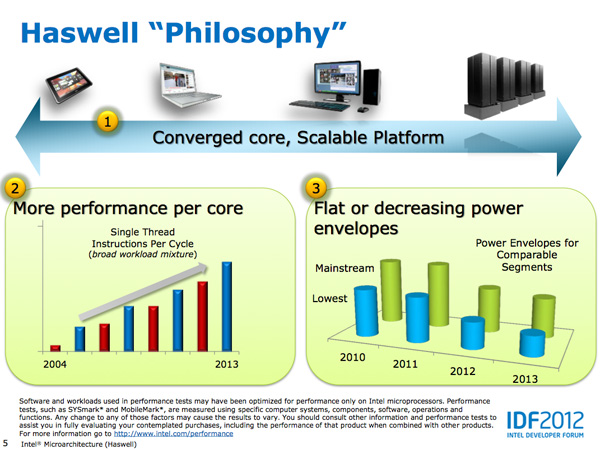Intel's Haswell Architecture Analyzed: Building a New PC and a New Intel
by Anand Lal Shimpi on October 5, 2012 2:45 AM ESTPrioritizing ILP
Intel has held the single threaded performance crown for years now, but the why is really quite easy to understand: it has prioritized extracting instruction level parallelism with every generation. Couple that with the fact that every two years we see a "new" microprocessor architecture from Intel and there's a recipe for some good old evolutionary gains. The table below shows the increase in size of some major data structures inside Intel's architectures for every tock since Conroe:
| Intel Core Architecture Buffer Sizes | ||||||
| Conroe | Nehalem | Sandy Bridge | Haswell | |||
| Out-of-order Window | 96 | 128 | 168 | 192 | ||
| In-flight Loads | 32 | 48 | 64 | 72 | ||
| In-flight Stores | 20 | 32 | 36 | 42 | ||
| Scheduler Entries | 32 | 36 | 54 | 60 | ||
| Integer Register File | N/A | N/A | 160 | 168 | ||
| FP Register File | N/A | N/A | 144 | 168 | ||
| Allocation Queue | ? | 28/thread | 28/thread | 56 | ||
Increasing the OoO window allows the execution units to extract more parallelism and thus improve single threaded performance. Each generation Intel is simply dedicating additional transistors to increasing these structures and thus better feeding the beast.
This isn't rocket science, but it is enabled by Intel's clockwork fab execution. Designers can count on another 30% die area to work with every 2 years, so every 2 years they increase the size of these structures without worrying about ballooning the die. The beauty of evolutionary improvements like this is that when viewed over the long term they look downright revolutionary. Comparing Haswell to Conroe, the OoO scheduling window has grown by a factor of 2x, despite generation to generation gains of only 14 - 33%.











245 Comments
View All Comments
Magik_Breezy - Sunday, October 14, 2012 - link
Anything delivers "solid performance" on Facebook & iWorkWhy pay $2,000 for that?
random2 - Friday, October 5, 2012 - link
I agree. admittedly I am not an apple fan and view them as people who have undergone a degree of brainwashing compounded by the need for some to keep up with the Jone's. A certain degree of mind control must be necessary to stick with a company that has had some questionable business practices as far as customer relations, dealing with product issues and denying said issues, not to mention the whole hypocritical stance by apple in regards to copyright infringement has also left a bad taste in my mouth.hasseb64 - Saturday, October 6, 2012 - link
Disagree, not that much new from already published IDF reports almost 1 month ago. What is intresting is the claimed 40 EU GT3, other sources say lower amounts.JKflipflop98 - Saturday, October 6, 2012 - link
I totally agree. It's articles like this that have kept me coming back for years. Keep up the good work Anand!tipoo - Sunday, October 7, 2012 - link
"You can expect CPU performance to increase by around 5 - 15% at the same clock speed as Ivy Bridge. "That seems terribly disappointing for a tock, even IVB as a Tick managed 10% in most cases.
medi01 - Tuesday, October 9, 2012 - link
One can't be biased !@# !@#@ and a good journalist at the same time.One needs to be blind not to see how glass is always half empty for AMD, and half full for nVidia/Intel. F**!@#'s were shameless enough, to test 45W APU with 1000W PSU and such crap is all over the place.
Paulman - Friday, October 5, 2012 - link
As I was reading this article, about part way into the low platform power sections I suddenly had this thought: "Oh man, AMD is gonna die...!"I don't know if that's true for the entire microprocessor side of AMD, since they look like they're already starting to transition out of the desktop space, but I don't know if they're going to stand much of a chance if they're planning on entering the same TDP range as Haswell.
Do you think there's a chance AMD will start focussing on designing ARM ISA cores? Or will expanding on their x86 Bobcat-type cores be enough for them?
sean.crees - Friday, October 5, 2012 - link
I also worry about AMD. AMD has been 1-2 steps behind Intel for a while now, and now it seems Intel is at least 1 or 2 steps behind ARM and the future. Is that going to mean AMD is just too far behind to stay relevant now? If nothing else, i suppose AMD can fall back on graphic cards with it's ATI acquisition.Da W - Friday, October 5, 2012 - link
If Haswell keeps x86 relevant in the tablet space and thus Windows 8 has the upper edge over Windows RT and Windows tablets can grab +-50% market share from the iPad, then it can be good for AMD, provided they survive that long.RedemptionAD - Friday, October 5, 2012 - link
If AMD can create a team to focus on increasing IPC with a goal to one up Intel and have the ATI graphics people keep doing what they do with a time goal of say 2 years, (Note: Portables/Notebooks/Desktops should all be x64 by then), then I think that AMD will be able to return to their Athlon 64 glory days or better.